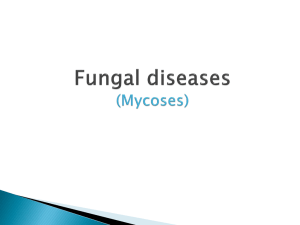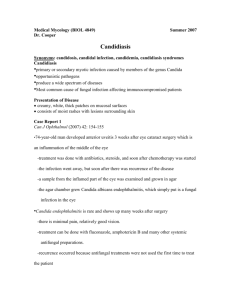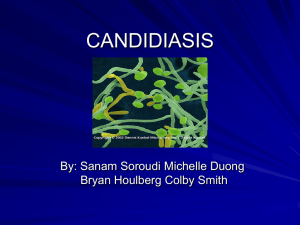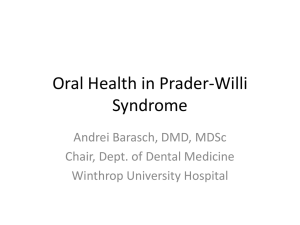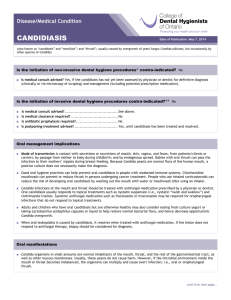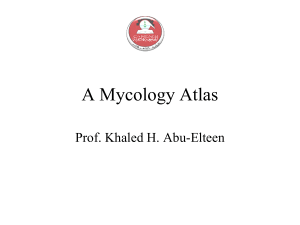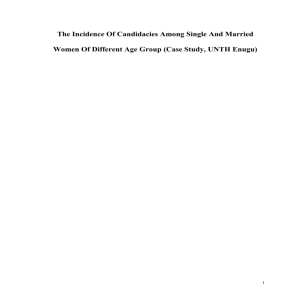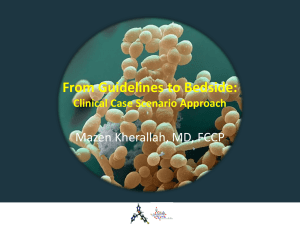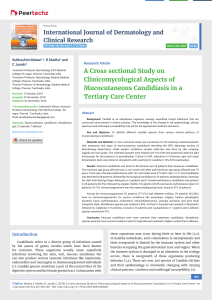noţiuni de sănătate publică, epidemiologie şi informatică
advertisement
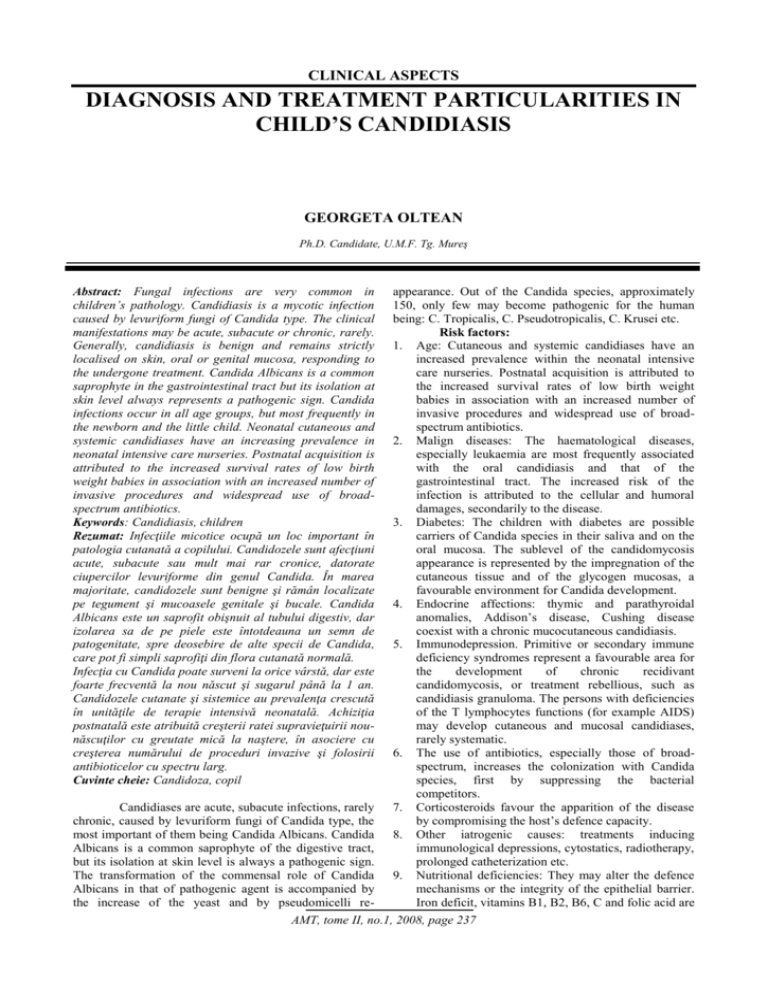
CLINICAL ASPECTS DIAGNOSIS AND TREATMENT PARTICULARITIES IN CHILD’S CANDIDIASIS GEORGETA OLTEAN Ph.D. Candidate, U.M.F. Tg. Mureş Abstract: Fungal infections are very common in children’s pathology. Candidiasis is a mycotic infection caused by levuriform fungi of Candida type. The clinical manifestations may be acute, subacute or chronic, rarely. Generally, candidiasis is benign and remains strictly localised on skin, oral or genital mucosa, responding to the undergone treatment. Candida Albicans is a common saprophyte in the gastrointestinal tract but its isolation at skin level always represents a pathogenic sign. Candida infections occur in all age groups, but most frequently in the newborn and the little child. Neonatal cutaneous and systemic candidiases have an increasing prevalence in neonatal intensive care nurseries. Postnatal acquisition is attributed to the increased survival rates of low birth weight babies in association with an increased number of invasive procedures and widespread use of broadspectrum antibiotics. Keywords: Candidiasis, children Rezumat: Infecţiile micotice ocupă un loc important în patologia cutanată a copilului. Candidozele sunt afecţiuni acute, subacute sau mult mai rar cronice, datorate ciupercilor levuriforme din genul Candida. În marea majoritate, candidozele sunt benigne şi rămân localizate pe tegument şi mucoasele genitale şi bucale. Candida Albicans este un saprofit obişnuit al tubului digestiv, dar izolarea sa de pe piele este întotdeauna un semn de patogenitate, spre deosebire de alte specii de Candida, care pot fi simpli saprofiţi din flora cutanată normală. Infecţia cu Candida poate surveni la orice vârstă, dar este foarte frecventă la nou născut şi sugarul până la 1 an. Candidozele cutanate şi sistemice au prevalenţa crescută în unităţile de terapie intensivă neonatală. Achiziţia postnatală este atribuită creşterii ratei supravieţuirii nounăscuţilor cu greutate mică la naştere, în asociere cu creşterea numărului de proceduri invazive şi folosirii antibioticelor cu spectru larg. Cuvinte cheie: Candidoza, copil Candidiases are acute, subacute infections, rarely chronic, caused by levuriform fungi of Candida type, the most important of them being Candida Albicans. Candida Albicans is a common saprophyte of the digestive tract, but its isolation at skin level is always a pathogenic sign. The transformation of the commensal role of Candida Albicans in that of pathogenic agent is accompanied by the increase of the yeast and by pseudomicelli re- appearance. Out of the Candida species, approximately 150, only few may become pathogenic for the human being: C. Tropicalis, C. Pseudotropicalis, C. Krusei etc. Risk factors: 1. Age: Cutaneous and systemic candidiases have an increased prevalence within the neonatal intensive care nurseries. Postnatal acquisition is attributed to the increased survival rates of low birth weight babies in association with an increased number of invasive procedures and widespread use of broadspectrum antibiotics. 2. Malign diseases: The haematological diseases, especially leukaemia are most frequently associated with the oral candidiasis and that of the gastrointestinal tract. The increased risk of the infection is attributed to the cellular and humoral damages, secondarily to the disease. 3. Diabetes: The children with diabetes are possible carriers of Candida species in their saliva and on the oral mucosa. The sublevel of the candidomycosis appearance is represented by the impregnation of the cutaneous tissue and of the glycogen mucosas, a favourable environment for Candida development. 4. Endocrine affections: thymic and parathyroidal anomalies, Addison’s disease, Cushing disease coexist with a chronic mucocutaneous candidiasis. 5. Immunodepression. Primitive or secondary immune deficiency syndromes represent a favourable area for the development of chronic recidivant candidomycosis, or treatment rebellious, such as candidiasis granuloma. The persons with deficiencies of the T lymphocytes functions (for example AIDS) may develop cutaneous and mucosal candidiases, rarely systematic. 6. The use of antibiotics, especially those of broadspectrum, increases the colonization with Candida species, first by suppressing the bacterial competitors. 7. Corticosteroids favour the apparition of the disease by compromising the host’s defence capacity. 8. Other iatrogenic causes: treatments inducing immunological depressions, cytostatics, radiotherapy, prolonged catheterization etc. 9. Nutritional deficiencies: They may alter the defence mechanisms or the integrity of the epithelial barrier. Iron deficit, vitamins B1, B2, B6, C and folic acid are AMT, tome II, no.1, 2008, page 237 CLINICAL ASPECTS associated with an increased rate of infections. In oral and digestive candidiasis, the deficiencies occurring as a result of malabsorption and malnutrition syndrome corroborate both with the general vitamin and nutritional deficit and with the decrease of secretory IgA, whose participation in the antiinfectious defence is essential. Clinical forms: Candidiasis of mucosas: Oropharyngeal candidiasis includes acute pseudomembranous stomatitis, glossitis, stomatitis, angular cheilitis (perlèche) and it usually represents a minor form. Clinically, it is presented under the form of certain white delimitated and adherent deposits, which after having been removed, it leaves a red, eroded mucosa, which bleeds more at the level of the oral mucosa and less at the level of tongue, gum and palate. Fig. 1 Oral candidiasis The symptoms may be absent or may include the feeling of dry burning mouth, pain swallowing or breast feeding disorders and swallowing difficulty. The oropharyngeal candidiasis among the newborn babies is usually acquired during birth, due to the mother’s infected genital mucosa. The nipple candidiasis in breast feeding women is associated with the infantile stomatitis. The differential diagnosis must be made taking into account the “grain milk”, which can be easily detached and the diphtheria membranes, which develop rapidly and accompany the general phenomena and the submandibular adenopathy. Perlèche represents a superficial and painful fissure at the level of the labial commissure, unilaterally or bilaterally, the most frequently produced by streptococcus or by yeast. In this case, it is covered by thick, white exudates instead of being covered by a meliceric crust. Vulvovaginal candidiasis is rarely encountered among the little girls than in adult women. Fig. 2 Mixed cheilitis Clinically, it is manifested by erythema, tumefaction of the vulval mucosa, which may be covered by yellow creamy deposits. It is accompanied by more or less intense itchiness. Its extension to the inguinal plicae may be possible. Cutaneous candidiasis (Intertrigo candidosic, diaper candidiasis) The majority of children having this form of candidiasis are Candida Albicans carriers, at the level of intestines and faeces. The factors favouring the diaper candidiasis include: skin local irritation as a result of rubbing, ammoniac resulted from the urea bacterial degradation, contaminated toilets and aggressive cleaning agents. Clinically: Red dry placards, usually covered by white deposits limited by a horn-like collaret, which may be red, vesiculous or juicy. Fig. 3 Diaper candidiasis Onixis with perionyxis Candida Albicans infects nails secondarily; the starting point being an inflammatory perionyxis of nails. When pressuring, a drop of pus may result from beneath the red labrum, which surrounds the nail. In opposition with onychomycosis caused by dermatophytes, the nail affection begins laterally or at its basis, in this case. The diagnosis requires laboratory examination. The differential diagnosis is made by taking into account the nail psoriasis, eczemas of the fingers accompanied by nails atrophy. Fig. 4 Onixis with candidiosic perionyxis Treatment The first step in candidiases management must be the correction of the factors, which favoured the skin and mucosa colonisation and the recovery of the normal skin barrier function, by avoiding the excessive humidity and rubbing. It is recommended to avoid the antibiotics abuse and in case of their use for long term, vitamin B complex is recommended, as well as lactic flora and Stamicin. Local treatment is sufficient in most of the cases. Colorants: - Gentian violet 1% represents the classic treatment of thrush and is applied by painting the oral mucosas with the glycerinate hydroalcoholic solution. AMT, tome II, no.1, 2008, page 238 CLINICAL ASPECTS The area will be alkalinized with borax glycerine 5% or by Na bicarbonate oral lavages. - Methylene blue and green methylene are usually active on the recto-genital mucosas. - For skin, it is recommended to use Streptomicosan (boric acid 7,5g, resorcin 7,5g, basic fuxin 2,25g, phenol 2,25g, acetone 37,5g, distillate water 650g.) or Castellany (saturate alcoholic solution of basic fuxin 10 ml, phenol aqueous solution 5% 100ml, boric acid 1ml, acetone 5ml, resorcin 5ml.). - Iodine is an efficacious agent, one of the most used agents are iodate alcohol, iodate glycerine, Lugol, solution, Betadine. For oral candidiasis, Nistatin suspension (100000u/ml) is recommended at 4-6 hours or after each meal and regarding the elder children, Stamicin sugarcoated tablets, which must be sucked although their taste is not agreeable at all. In candidosic perlèche, it is recommended to use silver nitrate solution once a day 0,5% or diluted Fenosept 1/10 and antimycotic ointments. In candidosic intertrigo, where the area is juicy, paintings with antiseptic solutions are recommended; subsequently, the following ointments could be used (Myconasol, Clotrimasol, Bifonasol, Fenticonasol etc.). For short term, combinations and topic steroids (hydrocortisone) may be used. Systemic antimycotic treatment is indicated in the severe cases, recidivation, onychomycosis or immunodepressed children. It will be better if the treatment is continued a few days after the clinical treatment and after Candidiasis disappearance, as a result of the laboratory examination. Ketoconasol, imidasolic derivate with broad spectrum. To children of 15-30 kg in weigh, the recommended daily dose is of 100mg./zi, and to those over 30 kg., the dose is similar as for adults, 200mg./zi. Prophylactic treatment in immunodefiency people is of 4-8mg/kg. Fluconasol is a tryasolic agent, the recommended dose is of 3-6mg/kg. It is active on species of Candida Albicans, but it may develop resistance; it is less active on nonAlbicans species (C. Glabrata, C. Krusei). Terbinafin, alilaminic derivate, used especially for paronychiae treatment in dose of 62,5mg for children between 12-12 kg, 125 mg for those between 12-20 kg, 125mg 20-40kg and 250mg for children with more than 40 kg in weight. 1. 2. 3. 4. 1. 2. 3. 4. 5. with medicines by the administration of antimycotics, vitamin B complex, digestive ferments in sick patients with biological deficiencies, as well as the correction of the risk factors. The majority of forms are benign and require only local treatment. The topic or contact antimycotics are used in the cutaneous and mucosal Candidiasis therapy and are not systematically absorbed at this level. The systemic treatment is recommended to the patients with immune deficiencies, recidivating infections, rebellious to the topic treatment, in nails affections; the doses are adapted according to age and weight. BIBLIOGRAPHY Eleweski BE.: Cutaneous mycoses in children. Br. J Dermatol 1996 jun 7-11. Fischer G., Rogers M.: Vulvar disease in children. Pediatric Dermatology 2000;17:1-6. Gerald LM, et al: Principles and practice of infectious diseases.6th ed 2005. Longhin S., Dimitrescu Al.: Dermatologie infantilă, Editura medicală Bucureşti 1979, 84-95. (Infantile dermatology). Maier N.: Patologie cutanată vol II, Casa cărţii de ştiinţă Cluj 1999, 29-33. (Cutaneous pathology, tome II. House of the Science Book). CONCLUSIONS The mycotic infections are common affections among children at early ages. There is a series of factors favouring the occurrence of this affection: debilitating health conditions of the organism with the reduction of the defence capacity, prematurity, diabetes, malign diseases, treatments which induce depressions, nutritional deficiencies, as well as local or environment factors, by producing irritations or lesions (irritating treatments of mucosas, occlusive diapers, irritating chemicals). The prophylactic measures are very important for the disease prevention and recidivation; the prophylaxis AMT, tome II, no.1, 2008, page 239
